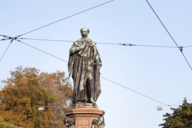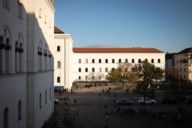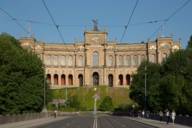
Max II Joseph of the House of Wittelsbach was the King of Bavaria from 1848 to 1864. He’s considered a patron of science and an early mountaineer. Despite his dedication to social activities, he wasn’t too popular with the people. He didn’t have a great relationship with his son either, who would later become the Fairytale King Ludwig II.
Maximilian (1811 – 1864) succeeded his father Ludwig I after his unexpected abdication in 1848. His mother was Therese of Saxe-Hildburghausen.
Tsar Nicholas I of Russia wanted his daughter Olga to marry the Bavarian heir to the throne in 1938, but Maximilian didn’t feel anything and refused – much to the Russian’s disgruntlement. A few years later at the age of 30, Max married Princess Marie Friederike of Prussia of the House of Hohenzollern when she was just 16 years old. Their marriage produced two sons: the legendary Fairytale King Ludwig II (who built the Neuschwanstein, Herrenchiemsee and Linderhof castles) and his brother Otto, who was three years younger and would also become king.
During his time as the Crown Prince, Max visited countries like Greece, Italy and England on his travels around Europe. He passionately climbed the Bavarian mountains alongside his wife Marie and their two sons, which is why they’re often seen as early mountaineers. The royal family would often stay at mountain lodges and Hohenschwangau Castle, and these places really fuelled the imagination of Ludwig, the future heir to the throne.

By the time he became king, the German revolution was in full swing. The solidarity amongst the monarchs ultimately let to its failure. Meanwhile, Max II was implementing reforms that initially seemed like more of an effort to quash the impending coup than to modernise the kingdom. He soon tried to get rid of the newly granted voting rights and freedom of the press, as he feared the revolution might return with a vengeance.
The reforms ultimately remained in place, however, and improved the rule of law, freedom of expression and participation rights. They also promised the Jews civil emancipation and liberated the peasants from their personal obligations towards landowners and lords. In terms of foreign policy, Max II tried to preserve Bavarian independence within the German Confederation.
The king was seen especially as a patron of science and the arts. embracing the technical innovations of the time. He managed to attract famous “northern lights” professors to the Ludwig-Maximilians-University, consolidating Munich’s reputation as a university city. He was particularly committed to the subject of history.
Max II established the Maximilian Order for Science and Art in 1853, which has remained the highest award in Bavaria to this day. He founded the Bayerisches Nationalmuseum in 1855, which now houses a collection of art and cultural history across 13,000 square metres. He was also the founder of the Maximilianeum, a Bavarian foundation for gifted and talented individuals. Its building now houses the Bavarian State Parliament.

Max II also introduced fundamental changes to the architectural style of royal urban planning concepts. Several structures emerged in a neo-Gothic Maximilian style, such as Maximilianstrasse and the glass palace at the Alter Botanischer Garten (park) which no longer exists.
Max II also preserved local customs, incorporating traditional costumes at his ceremonies and wearing jackets with lederhosen during hunting trips to improve the courtly image of Munich’s traditional dress. The king was also aware of the social hardship of the working class – but he still wasn’t the people’s favourite. He was seen as hesitant and reserved.
In 1864, Max II died suddenly at the age of 52 following a brief but serious illness that was attributed to an erysipeloid chest infection. The eight-year-old heir to the throne, Ludwig II, wasn’t properly prepared for his future duties. This was also due to the distant relationship between father and son. It was apparently quite a strenuous affair for the king to take Ludwig on his morning walks. He just didn’t know what to talk about with the boy.